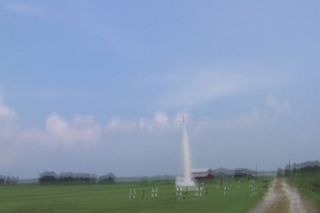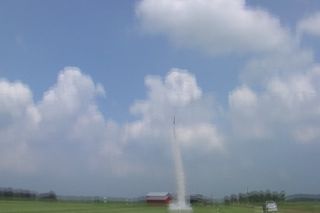NEFAR Launch
August 13, 2005
Sugar Rush A:

Video (12 megs .wmv file, 2 minutes
playing time)
Nice launch, despite the old, sodden grains. Apogee at 2227 feet,
dual deployment worked, although I notice that the rocket falls quite a ways
before the drogue pops out. It's done that on the last few launches.
Sugar Rush B:

Video (12 megs .wmv file, 2 minutes
playing time)
This is a more "interesting" flight. It zig-zags severely upon leaving
the launch rod, then swishes like crazy to 665 feet where the ejection charge
fires right after burnout. Good thing my drogue chute is in tatters,
or I would have had a major zipper there. Another "pop" is heard a
second or so later, thought to be the second ejection charge firing. But
both of the parachutes are out already! What gives?
Upon disassembly, I saw that the altimeter was displaced toward the aft,
jarred loose from its CPR-3000 retaining tube. In fact, the fore-end
sealing unit was broken off from the altimeter circuit board, which is now
dangling by the ignitor wire. So at first guess, it seems that the
aft charge fired prematurely, popping off the aft section and deploying the
drogue. Inertia could have "ejected" the main chute, despite the single
nylon retaining pin.
A second or two later, the airframe passed the 600 foot mark, and the altimeter
dutifully fired the second ejection charge, which was intended to deploy the
main.
Problem with this idea is that the altimeter broke in the opposite direction,
suggesting that it would have fired first, popped out the main chute, and
the drogue was deployed by inertia. Looking at the video, this seems
quite possible. But that is backwards! No only should the drogue
have fired first, but what was second "pop" at exactly the right time?
One possibility is that the violent oscillations somehow shook the altimeter
into a "test" mode, where one ignitor is fired precisely (?) one second after
the other. Firing of the first charge blew the altimeter end-cap off,
leaking enough gas to the other end to eject the main.
Speculation is rampant. Opinions are welcomed.
Jimmy Yawn
jyawn@sfcc.net
Recrystallized Rocketry

